Abstract
The effects of non-steroidal anti-inflammatory drugs and prostaglandins E2 and F2α on the secretory and electrical activity of isolated rabbit fundic mucosa have been studied. Spontaneous acid secretion was inhibited by serosal side application of sodium thiocyanate (6×10−2M) and the resulting alkali secretion measured by pH stat tiration. Serosal side application of indomethacin (10−5M) or aspirin (3×10−3M) inhibited alkali secretion (0·55±0·06 to 0·12±0·06 μmol/cm2/h, n=6, p<0·01 and 0·28±0·06 to 0·11±0·03 μmol/cm2/h, n=7, p<0·02 respectively). Mucosal or serosal side prostaglandin E2 (10−5 to 10−10M) and F2α (10−4 to 10−10M) failed to alter the rate of alkalinisation but secretion was significantly increased by serosal side 16,16-dimethyl-prostaglandin E2 (10−6M) (0·90±0·20 to 1·50±0·30 μmol/cm2/h, n=6, p<0·01). Serosal side application of 10−6M prostaglandin E2 to fundic mucosae pretreated with either aspirin (5×10−3M) or indomethacin (10−5M), to reduce endogenous E2 formation, also failed to alter alkali secretion. Pretreatment of the mucosa with 16,16-dimethyl-E2 (10−6M) abolished the inhibitory effect of indomethacin (10−5M) on alkali secretion (n=6) but did not modify the secretory response to aspirin (3×10−3M) (fall in alkali secretion with aspirin = 81±11% and with aspirin plus 16,16-dimethyl-E2 = 72±10%, n=7). In the doses used, none of the prostaglandins or non-steroidal anti-inflammatory drugs altered transmucosal potential difference or electrical resistance. These results show that the damaging agents, aspirin and indomethacin, both inhibit gastric alkali secretion but that modes of action may differ. The observation that prostaglandins, E2 and F2α failed to increase alkali production suggests that their protective activity against a variety of damaging agents as shown by others, may be mediated by another mechanism.
Full text
PDF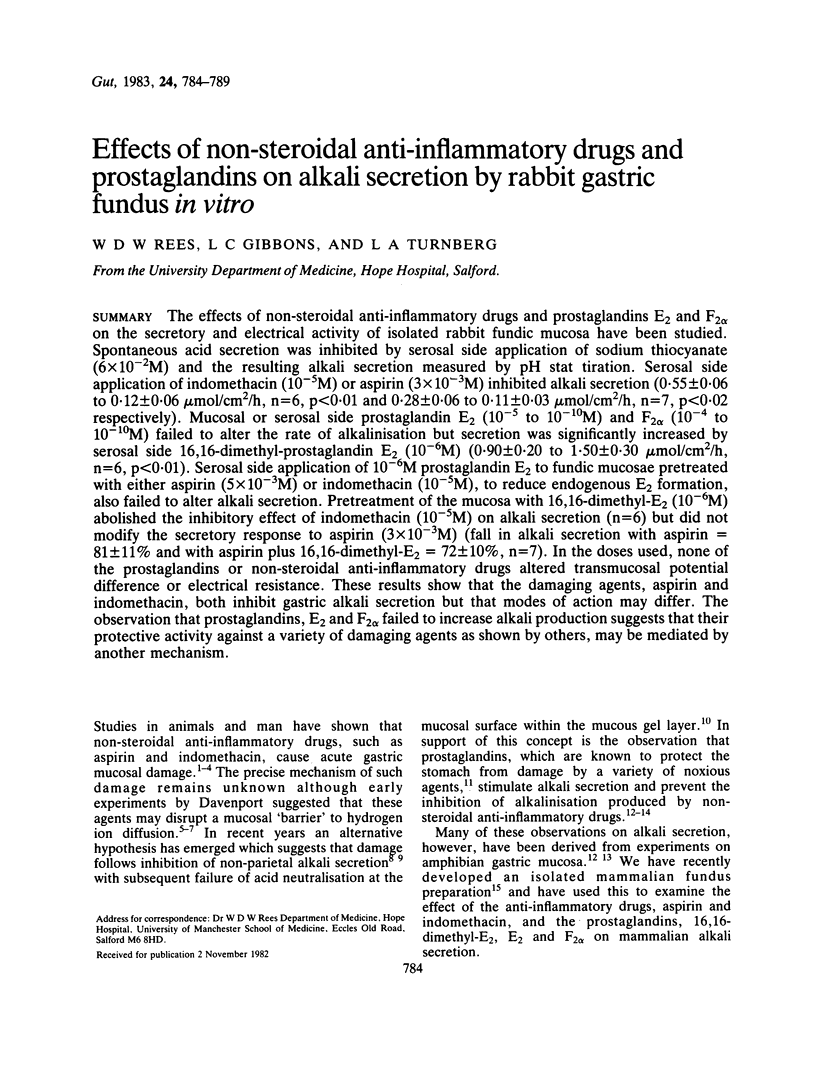
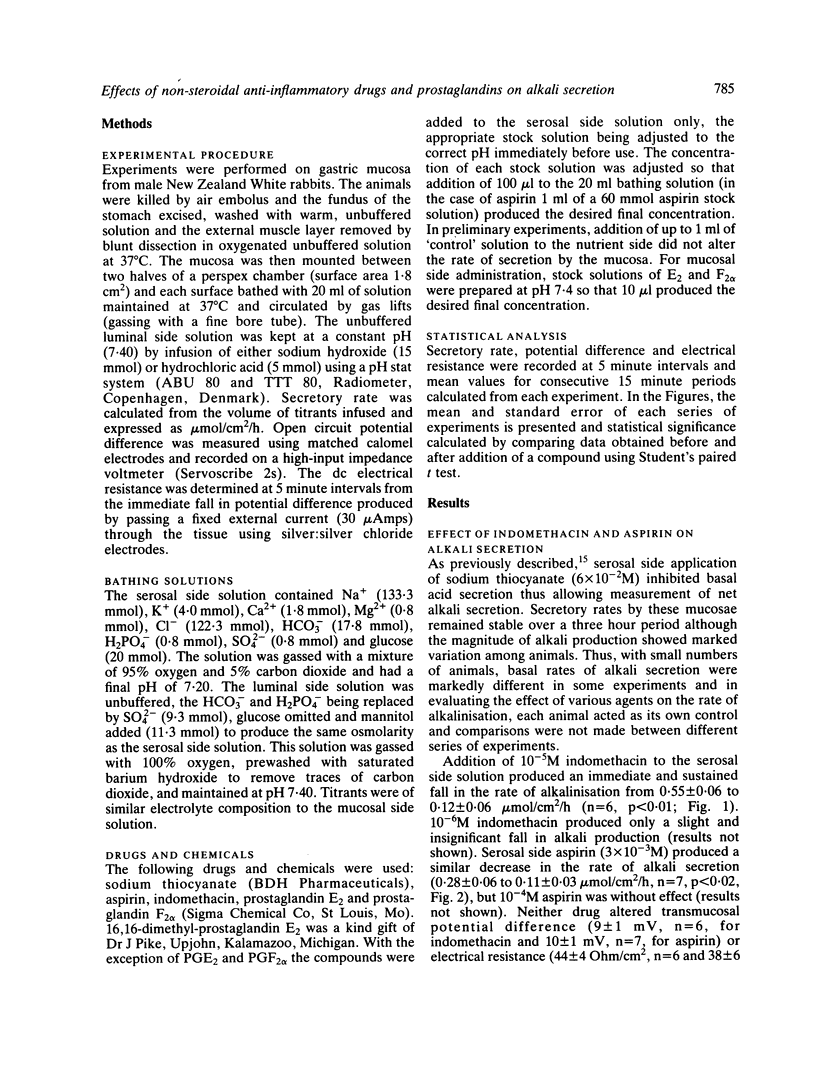
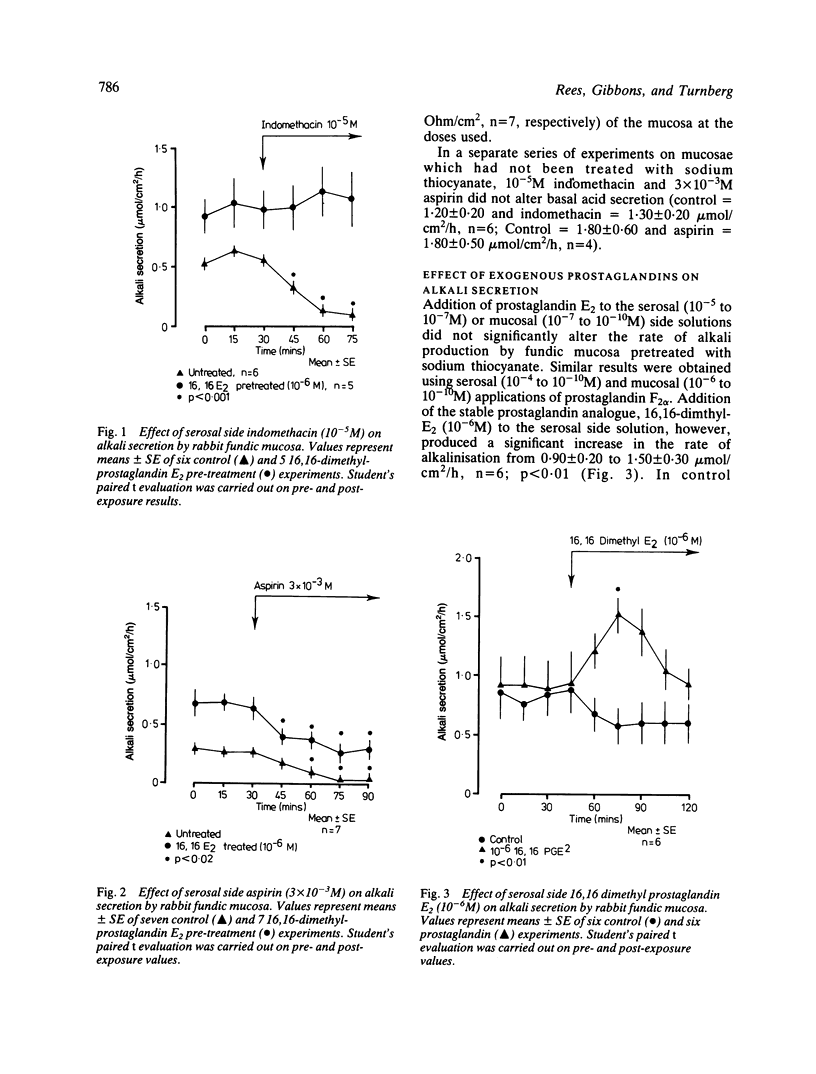
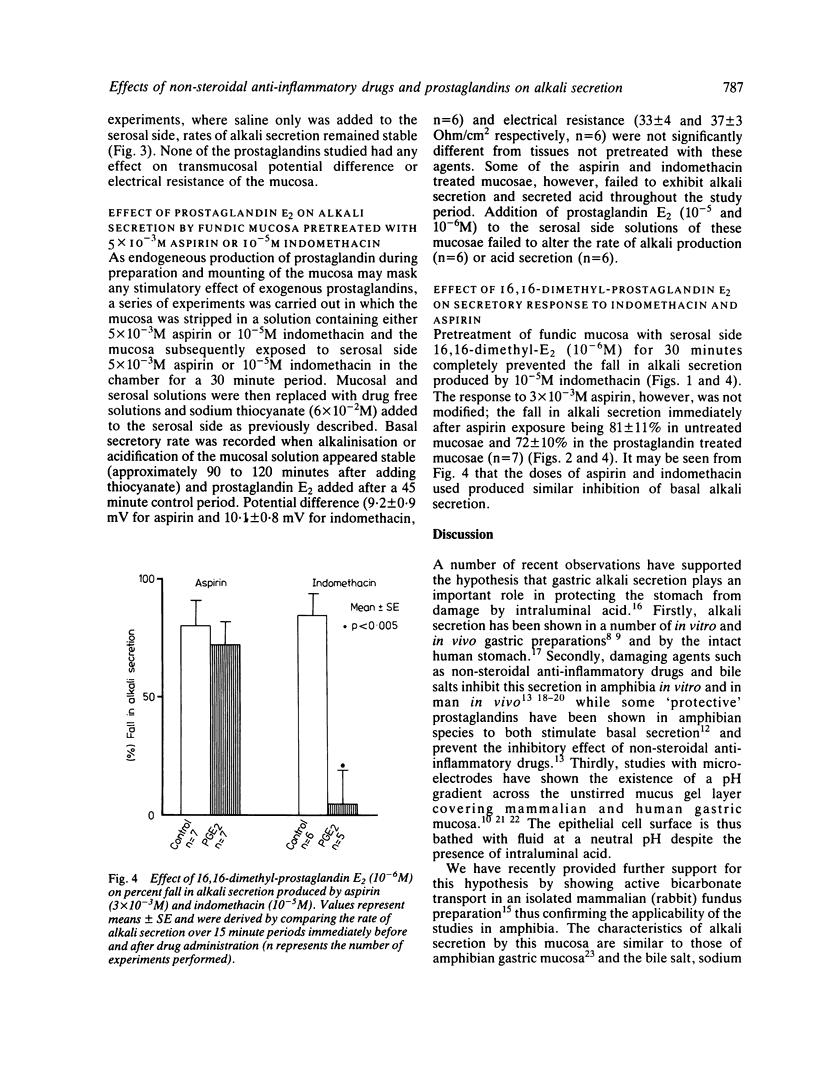
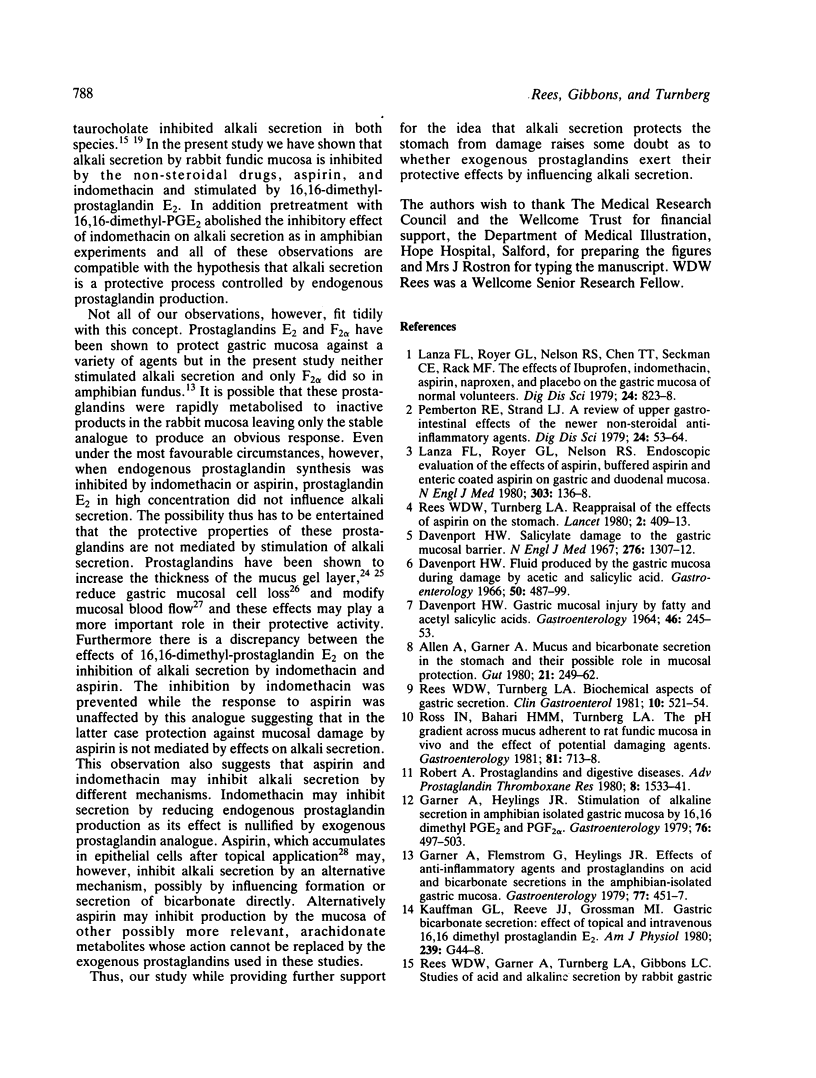
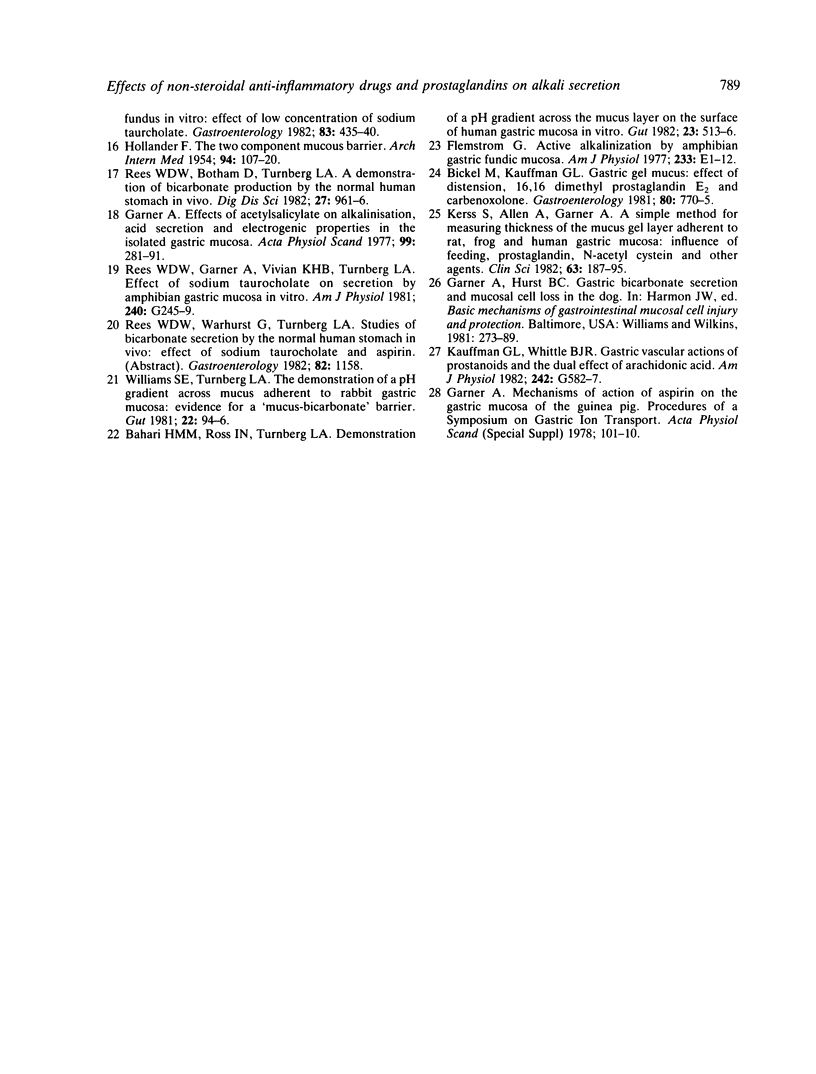
Selected References
These references are in PubMed. This may not be the complete list of references from this article.
- Allen A., Garner A. Mucus and bicarbonate secretion in the stomach and their possible role in mucosal protection. Gut. 1980 Mar;21(3):249–262. doi: 10.1136/gut.21.3.249. [DOI] [PMC free article] [PubMed] [Google Scholar]
- Bahari H. M., Ross I. N., Turnberg L. A. Demonstration of a pH gradient across the mucus layer on the surface of human gastric mucosa in vitro. Gut. 1982 Jun;23(6):513–516. doi: 10.1136/gut.23.6.513. [DOI] [PMC free article] [PubMed] [Google Scholar]
- Bickel M., Kauffman G. L., Jr Gastric gel mucus thickness: effect of distention, 16,16-dimethyl prostaglandin e2, and carbenoxolone. Gastroenterology. 1981 Apr;80(4):770–775. [PubMed] [Google Scholar]
- DAVENPORT H. W. GASTRIC MUCOSAL INJURY BY FATTY AND ACETYLSALICYLIC ACIDS. Gastroenterology. 1964 Mar;46:245–253. [PubMed] [Google Scholar]
- Davenport H. W. Fluid produced by the gastric mucosa during damage by acetic and salicylic acids. Gastroenterology. 1966 Apr;50(4):487–499. [PubMed] [Google Scholar]
- Davenport H. W. Salicylate damage to the gastric mucosal barrier. N Engl J Med. 1967 Jun 8;276(23):1307–1312. doi: 10.1056/NEJM196706082762308. [DOI] [PubMed] [Google Scholar]
- Flemström G. Active alkalinization by amphibian gastric fundic mucosa in vitro. Am J Physiol. 1977 Jul;233(1):E1–12. doi: 10.1152/ajpendo.1977.233.1.E1. [DOI] [PubMed] [Google Scholar]
- Garner A. Effects of acetylsalicylate on alkalinization, acid secretion and electrogenic properties in the isolated gastric mucosa. Acta Physiol Scand. 1977 Mar;99(3):281–291. doi: 10.1111/j.1748-1716.1977.tb10381.x. [DOI] [PubMed] [Google Scholar]
- Garner A., Flemström G., Heylings J. R. Effects of antiinflammatory agents and prostaglandins on acid and bicarbonate secretions in the amphibian-isolated gastric mucosa. Gastroenterology. 1979 Sep;77(3):451–457. [PubMed] [Google Scholar]
- Garner A., Heylings J. R. Stimulation of alkaline secretion in amphibian-isolated gastric mucosa by 16,16-dimethyl PGE2 and PGF2 alpha. A proposed explanation for some of the cytoprotective actions of prostaglandins. Gastroenterology. 1979 Mar;76(3):497–503. [PubMed] [Google Scholar]
- HOLLANDER F. The two-component mucous barrier; its activity in protecting the gastroduodenal mucosa against peptic ulceration. AMA Arch Intern Med. 1954 Jan;93(1):107–120. doi: 10.1001/archinte.1954.00240250117009. [DOI] [PubMed] [Google Scholar]
- Kauffman G. L., Jr, Whittle B. J. Gastric vascular actions of prostanoids and the dual effect of arachidonic acid. Am J Physiol. 1982 Jun;242(6):G582–G587. doi: 10.1152/ajpgi.1982.242.6.G582. [DOI] [PubMed] [Google Scholar]
- Kerss S., Allen A., Garner A. A simple method for measuring thickness of the mucus gel layer adherent to rat, frog and human gastric mucosa: influence of feeding, prostaglandin, N-acetylcysteine and other agents. Clin Sci (Lond) 1982 Aug;63(2):187–195. doi: 10.1042/cs0630187. [DOI] [PubMed] [Google Scholar]
- Lanza F. L., Royer G. L., Jr, Nelson R. S., Chen T. T., Seckman C. E., Rack M. F. The effects of ibuprofen, indomethacin, aspirin, naproxen, and placebo on the gastric mucosa of normal volunteers: a gastroscopic and photographic study. Dig Dis Sci. 1979 Nov;24(11):823–828. doi: 10.1007/BF01324896. [DOI] [PubMed] [Google Scholar]
- Lanza F. L., Royer G. L., Jr, Nelson R. S. Endoscopic evaluation of the effects of aspirin, buffered aspirin, and enteric-coated aspirin on gastric and duodenal mucosa. N Engl J Med. 1980 Jul 17;303(3):136–138. doi: 10.1056/NEJM198007173030305. [DOI] [PubMed] [Google Scholar]
- Pemberton R. E., Strand L. J. A review of upper-gastrointestinal effects of the newer nonsteroidal antiinflammatory agents. Dig Dis Sci. 1979 Jan;24(1):53–64. doi: 10.1007/BF01297239. [DOI] [PubMed] [Google Scholar]
- Rees W. D., Botham D., Turnberg L. A. A demonstration of bicarbonate production by the normal human stomach in vivo. Dig Dis Sci. 1982 Nov;27(11):961–966. doi: 10.1007/BF01391739. [DOI] [PubMed] [Google Scholar]
- Rees W. D., Garner A., Turnberg L. A. Studies of acid and alkaline secretion by rabbit gastric fundus in vitro: effect of low concentrations of sodium taurocholate. Gastroenterology. 1982 Aug;83(2):435–440. [PubMed] [Google Scholar]
- Rees W. D., Garner A., Vivian K. H., Turnberg L. A. Effect of sodium taurocholate on secretion by amphibian gastric mucosa in vitro. Am J Physiol. 1981 Mar;240(3):G245–G249. doi: 10.1152/ajpgi.1981.240.3.G245. [DOI] [PubMed] [Google Scholar]
- Rees W. D., Turnberg L. A. Biochemical aspects of gastric secretion. Clin Gastroenterol. 1981 Sep;10(3):521–554. [PubMed] [Google Scholar]
- Robert A. Prostaglandins and digestive diseases. Adv Prostaglandin Thromboxane Res. 1980;8:1533–1541. [PubMed] [Google Scholar]
- Ross I. N., Bahari H. M., Turnberg L. A. The pH gradient across mucus adherent to rat fundic mucosa in vivo and the effect of potential damaging agents. Gastroenterology. 1981 Oct;81(4):713–718. [PubMed] [Google Scholar]
- The gasman goeth. Lancet. 1980 Aug 23;2(8191):409–409. [PubMed] [Google Scholar]
- Williams S. E., Turnberg L. A. Demonstration of a pH gradient across mucus adherent to rabbit gastric mucosa: evidence for a 'mucus-bicarbonate' barrier. Gut. 1981 Feb;22(2):94–96. doi: 10.1136/gut.22.2.94. [DOI] [PMC free article] [PubMed] [Google Scholar]


